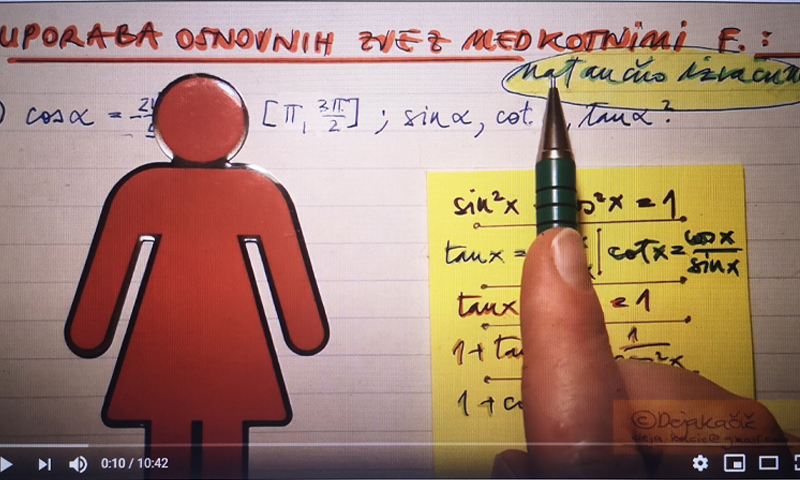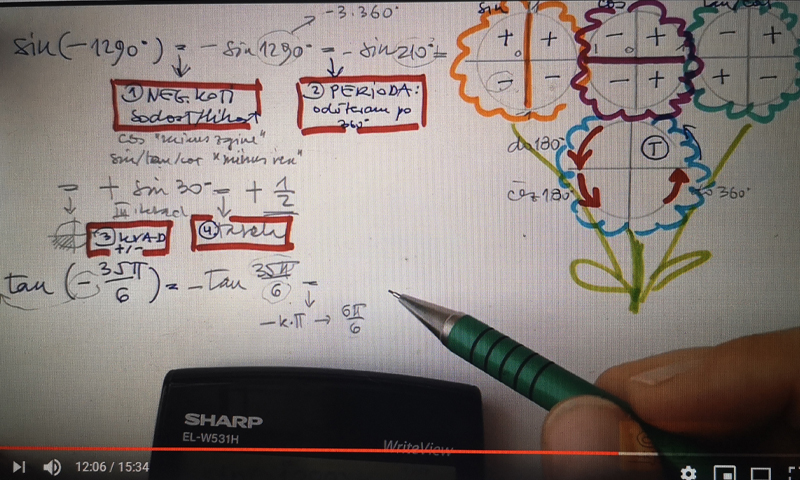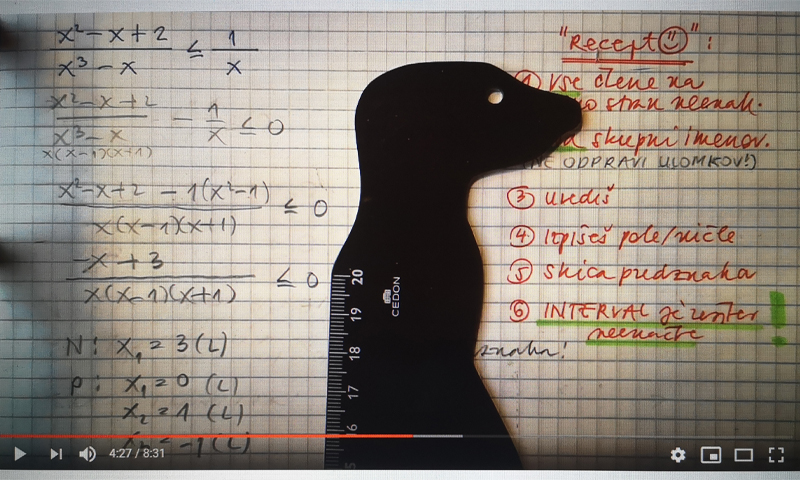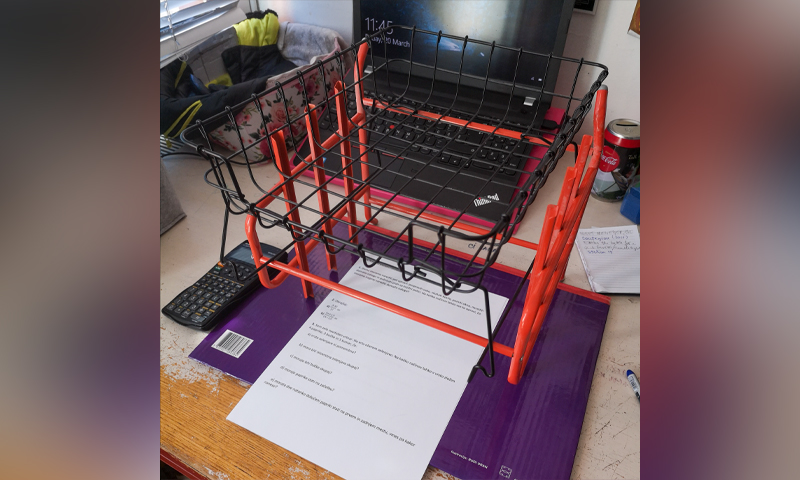Deja Kačič finished her mathematical studies at Faculty for mathematics and physics in Ljubljana, Slovenia and now teaches Mathematics and Mathematics for kindergarten in Secondary Preschool Education, Grammar school and Performing Arts Grammar School Ljubljana, Slovenia. In the past years, she held presentations on the assessment of student’s knowledge online and taught seminars on Kindergarten mathematics education for kindergarten teachers. For the past 3 years, she is also a Scientix ambassador for Slovenia and took part in European Space Agency workshop learning about Space in education.
In the beginning of March, I had two choices. First one was the easy way out – list the pages in the textbook and instruct the students: read, learn and exercise! Almost no work for me, a whole lot of trouble for the students. That would not be ethical or professional of me. The obtained student’s knowledge would probably not meet the curriculum criteria, or the students would just give up on trying to understand anything – I know I would teach mathematics in secondary school to teenagers. Imagine seeing a trigonometry proof for the first time, without a face to face explanation. Scary thought! The second choice was time-consuming for me, way too much work and a scary journey into the unknown of interactive technology available out there in the cyber universe. Of course, stubborn as I am, I chose the latter. That choice was better for the students. With videos and interactive explanations they would hopefully gain a deeper understanding of the subject, learn it on their own merit with my explanation and guidance and the knowledge would be long-lasting.

With mathematics, I see three main challenges of online teaching: how to explain and present mathematics without face to face interaction, how to keep a record of student’s homework and assignments in real-time and how to assess their knowledge in the end. For assessment I could use different internet platforms and applications – it was just a matter of trying them out and finding the one that suits my students and it is easy to use for mathematics. Online classroom provided me with the tools to keep progress with student’s homework and assignments fairly easy. They sent in photos or scans, I gave them feedback in an email or directly in the video chat we had scheduled each week. Video chats I also used for monitoring their progress and an additional one on one explanations of specific problems if needed, after they have been given the lesson already. I connected my tablet and shared my screen in real-time while solving the problems. When it comes to explaining new mathematical principles online (like trigonometry, polynomial functions, rational inequalities), I struggled a while. It had to be clear, engaging, technically correct and it would be best if students could see/read/hear it more than once – or to go back to the parts which they did not understand.
First, I tried just writing down my usual classroom talk. It worked for the definitions and explanations of the terms but writing down equations made me think further. When a student of mine would read through it, would he or she be able to see the process of solving the equation or would they just see a whole bunch of numbers, operators and x, y and z, all jumbled together? In my opinion mathematical equation (or graph, or function) is a process that has to evolve in front of your eyes. One must see the steps of the equation as they are being written down to be able to understand it and use it again on a similar equation. When you look at it, solved already you must have a deeper understanding of it to be able to decipher the steps by yourself. So, this meant that my first solution would not work for most of my students. The natural second choice was to go online and search for other people’s pre-recorded public lessons. There are plenty, mostly in English. The problem is that my students and I are not native English speakers, so to link lessons in English would be a double challenge for them.

Knowing their English proficiency mathematical and language barrier would be too much for most. There were only a few lessons in Slovenian. I binge watched a lot of them, looking for clarity of explanation, appropriate tasks, too much or not enough data for our curriculum, visualization of the problems. Some I found could work for my online classes, most of them, knowing my students, their learning habits and level of understanding, I had a feeling they would still struggle with or need an extra explanation. The third choice was to record my video explanations. Mind you, I did not know about video recording, video editing or YouTube. The only real equipment I had was my old smartphone and a laptop. On top of all that I would have to record 21 school hours of material for each week.
That seemed a lot. In the end, I decided on a mixture of all the choices taking into consideration that it must be interactive, engaging and easy for students to do it on their own. My own recorded lessons would be best, but no student’s span of attention online is equal to one in the classroom where you as a teacher constantly monitor their engagement, working, writing, understanding. When you see somebody’s attention drifting away, you can always change the lesson quickly and bring them back with a joke, different approach, a call by their name. A 45 min recorded video lesson is too long. An explanation of the basic facts plus a proof in about 10 to 15 minutes seemed like the way to go.
I constructed my own recording—a vertical phone stand from old stationary stands and cable ties. Under it, an old A3 paper folder was the green screenwriting station. I prepared in advance what I wanted to say in the video and wrote »cheat sheet formulas to use while explaining. I tried to make each video at least a little funny and interactive with not-so-math drawings or jokes and placing different cheat sheets with things to remember on the original page while filming. I believe that a formula or definition is easier to remember when you give it a visual or auditory anchor. recorded my hands writing, explaining the given subject, with loads of colour pens. I used the same introduction and the same two rulers—a pink girl and brown meerkat in each video to connect all the videos together.

In my opinion, mathematics must be vivid in colour and explanation – it has to be visual and online lessons even more so because you are not there to make it fun and playful. Doing mathematics means doing mistakes. When you exercise, do tasks or examples an eraser is an essential tool. You learn from the mistakes. I always teach my students not to try and find the mistake in an equation that did not produce the correct solution but instead try to solve it again on another paper. Your brain will try to look for the patterns and when in the process of solving the equation you write down something different—a sum, a minus, a product, an x. You will know where you made a mistake in the first place – then you take an eraser and correct the mistake, learning from it. How to translate that into the video?
I wanted to show my students that making mistakes s human and ok—so if I noticed a mistake in my calculations after recording the 10-minute video in one take, I purposely did not edit it out or rerecord the whole thing. It took me quite a lot of my free time, but I learned to use video editing software. I edited notes on the video. The note would say: ‘Now, that was wrong!!!’ or ‘Uff, let’s not do that!’ and then I would add another note with the correct answer or equation process. Converting the video after the recording and editing took a lot of time on my laptop, meanwhile, I constructed the lesson plan for the students in the online classroom— this is where my choice one and two from above came in handy—writing down explanation and public internet resources. For each lesson, I first wrote down where one can find it in the textbook, the key curriculum goals, and the summary.

I found a funny story, a puzzle, crossword, or meme to start the lesson. Sometimes I linked a video with the real-life application of a given subject. After that, I wrote down a short explanation and attached a link to my video. I also attached a handout for the students to solve while watching the video or I wrote down what they should be writing in their notebooks and what they should be extra careful not to miss. In the end, I usually linked a couple of other public videos from other teachers—if somebody needed a different approach to an explanation and some extra practice. I firmly believe that each student can understand mathematics if explained suitable for them.
One online lesson took almost twice the time to prepare than the face-to-face one in the classroom. I must admit for some lessons I took the easier way out—and linked public videos, or just solved the tasks with notes on them and scanned them. I mostly used the video recording for a new unknown subject and easy way to practice lessons. The equation for good online mathematics is not universal—by my students feedback I believe I did find one that was suitable for them and gave them a chance to study mathematics at home with my guidance and with good lasting results. Some of them thrived, some not—but most of them said that they finally know how to approach mathematics without the built-in anxiety. That should be the goal—make it fun and friendly, online or face to face.




